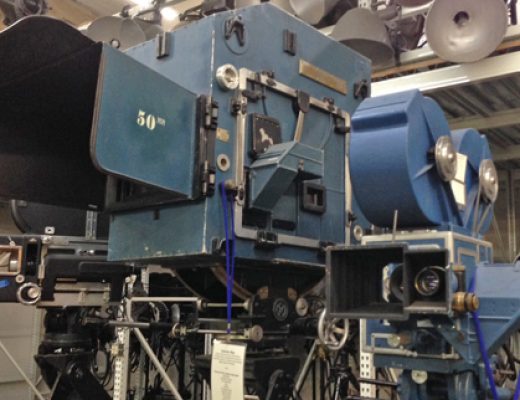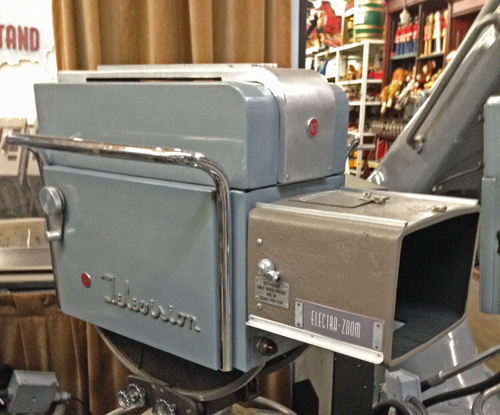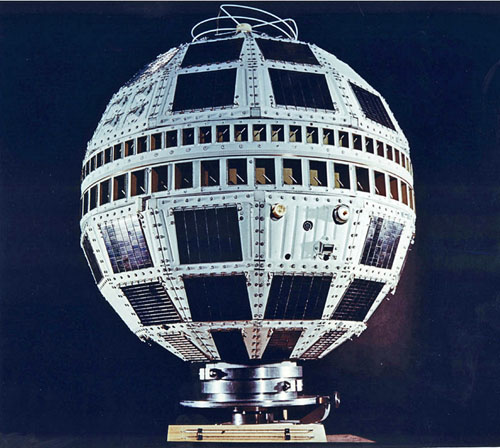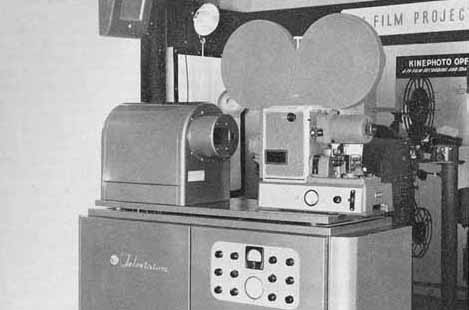As cable television’s customer base shrinks due to the rise in Internet Protocol Television (IPTV) delivery and driven by the use of mobile devices, it’s appropriate to look back at cable’s beginning. Before there was HBO, Showtime, Superstations or CSpan, there was Community Antenna Television.
It’s hard to imagine the world of seemingly endless amounts of television programming in America was once limited to a maximum of seven but more likely only one to three choices. In 1949, the latter was the norm in most cities as television stations went on the air as fast as they could build them. But as one went farther out of metropolitan areas, stations became scarce and the variety of terrain across the USA stopped many television signals at the first large hill blocking their way.
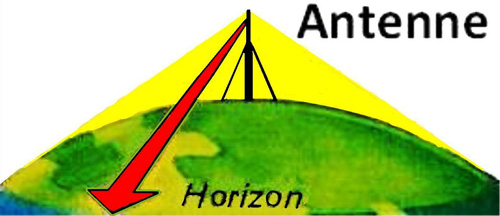
The earth’s curvature combined with mountainous terrain block the travel of VHF television signals. From Wikipedia
Over the air VHF signals travel line of sight. They don’t pass through mountains and the earth’s curvature makes them impossible to catch after a certain distance. In places like the Appalachian Mountains of Pennsylvania, the Ozarks of Arkansas, or the Cascades in the Northwest, unless you lived on top of the mountain, there was no point in owning a TV.
Necessity is the mother of invention even if the necessity was early television. With its dramatic rise and sudden demand, many small towns in mountainous areas felt left off the television bandwagon. In addition, local electronics stores wanted to sell television sets and reap the rewards their counterparts closer to the bigger cities were getting. And why not? By all accounts, televisions were flying off the shelves. Television quickly became a license to print money. Except no one wanted to buy a television if there was nothing to see.
As in all stories where enterprising individuals see a need and step in to fill it, several individuals came up with a plan to access faraway television signals by erecting an antenna on top of a local mountain, running a wire down into the town and distributing the signal into people’s homes. Hence the name – Community Antenna Television or CATV.
According to most accounts, the three most likely contenders for the right to say “We Did it First” are Jim Davidson in Tuckeman, Arkansas, Leroy “Ed” Parsons of Astoria, Oregon, and John Walson of Mahanoy City, Pennsylvania.
To this day, there is still controversy over who did it first. Each of these men began his service in 1948. One author, Thomas P. Southwick in his book “Distant Signals” hands the award to Davidson in Arkansas. Davidson began his system with one paying customer and one lone signal from WMC-TV in Memphis. However, the decision is questionable as WMC-TV didn’t officially sign on until December of 1948. All Davidson’s system provided his lone customer until then was WMC’s transmitter tests of a test pattern.
Ed Parsons in Astoria, Oregon, also had a system ready to go before the first television station in the Pacific northwest, KRSC-TV, Seattle (now KING-TV), signed on. Parsons was relaying that test pattern as early as September, 1948. He too, only had a single customer.
In both these cases, the argument for “Community Antenna” is lost since the service wasn’t being delivered to more than one party. Also, only one station’s signal was provided but and only test patterns with no programming until later.
In Philadelphia, Pennsylvania, the first television station went on the air as experimental station W3XE in 1932 and became WPTZ-TV (now KYW-TV) September 1, 1941, the third television station to be commercially licensed and the first one outside of NYC. The station, while curtailing programming during World War II, has been in continuous operation for 72 years. Then came WFIL-TV (now WPVI) in September 13, 1947. The last of the three original VHF stations, WCAU-TV, took to the air on May 23, 1948 with regular programming.
All three networks broadcasting at that time were represented by these stations – NBC, CBS and DuMont. ABC wouldn’t begin broadcast operations until April 19th, 1948 and WFIL-TV would carry both networks until DuMont closed down in 1956.
Stay with me here, this does come back around to CATV.
Shortly after World War II, homes began modernizing with new devices such as electric ranges and clothes dryers. It was in power companies’ best interests to get electrically driven appliances into the hands of American consumers so they would consume more electricity. So many of the companies became dealers for these new, labor saving appliances.
Pennsylvania Power and Light Company (PP&L) was no exception. Their service technicians would install and also repair these appliances. This adjunct to their business didn’t last long as it became apparent it was a conflict of interest with department stores and appliance dealers across their territory.
The 2005 Cable Hall of Fame Honoring John Walson
When PP&L got out of the appliance business in 1947, one of their service technicians in Mahanoy, Pennsylvania, about 80 miles from Philadelphia, began moonlighting, opening his own small business. When not climbing poles and stringing power lines, John Walson and his wife tended to their appliance shop after taking on franchises for various products including televisions.
Mahanoy, Pennsylvania, promotional video
The little town of Mahanoy is in a valley, completely blocked on all sides by mountains. Needless to say, Walson was not able to exhibit working televisions in his shop at the corner of Main and Pine downtown. In a recorded interview with researcher Mary Alice Mayer (and available online at The Cable Center Barco Oral History Collection), Walson tells the story of how he found a spot up on Broad mountain, purchased a 70 foot pole from the power company and installed an antenna on it. He ran about a mile of twin lead cable down to his shop adding an amplifier every 500 feet. Using this distant antenna, he could demonstrate all three Philadelphia television channels in the window of his store.

300 Ohm Twin Lead Antenna Wire commonly used as antenna wire in early television receiver installations.
In June of 1948, he became interested in selling the antenna service when he saw crowds gather in front of his store to watch the three sets. He put speakers outside and people would bring lawn chairs and either sit or stand watching into the night until the stations signed off at midnight.
Walson’s experience and close relationship with the power company afforded him the knowledge of running cables and negotiating rights. Initially, he wasn’t charged for pole access along the power company’s right of way. His project was an immediate hit and before long he was serving over 700 customers.
It would seem the award of “first” should then fall to John Walson.
Where there is controversy in the case of Walson, is that he initially used twin-lead. Twin lead has a severe attenuation problem and whenever it would rain, the signal on Walson’s system would degrade to snow. According to Robert B. Cooper, writing for the Old CATV Equipment Museum, twin-lead in American terminology is not the same as cable. When the FCC assumed authority over cable television in the 1960’s, they would define a CATV system as meeting several criteria, one of them being the system must be entirely shielded by coaxial cable and properly shielded components.
Within a year, Walson converted the whole system over to the better quality and weatherproof coaxial cable, not to conform to any rule, but to give his customers better service. In June of 1948, Walson’s system did not meet these requirements. But the most obvious criteria, that of providing multiple station signals with multiple paying customers watching signals delivered to their homes across public right of ways, were successfully met.
I believe the controversy is a little like laying down the rules of a race after it has been run. While the controversy may live on, Walson’s recognition is official. In spring of 1979 both the U.S. Congress and the National Cable Television Association (NCTA) declared John Walson created “the nation’s first cable television system in 1948.”
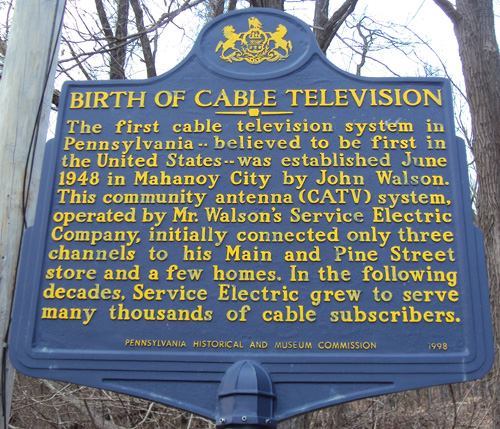
Pennsylvania Historical Marker in Mahanoy, Pennsylvania
But we aren’t finished with Walson. In 1950, he would be the first to bring distant New York City independent stations to his customers. Another entrepreneur was wiring Mahanoy with a competing system. To set himself apart from the competition, Walson set out to deliver more channels and therefore, more programming, to his customers.
Two independent stations had signed on in the New York area since Walson opened his system. The New York stations are 150 miles from Mahanoy. To make this happen, he stacked standard receiving antennae as high as 32 tall for one channel. He was able to bring in viewable pictures from both the new stations – WPIX-TV, Channel 11 and WOR-TV, Channel 9 (now WWOR-TV). Later, Walson would replace the off air antennae with the first private microwave network and bring near broadcast quality signals to his customers.
Even today, many of us don’t really need cable to receive over the air broadcasting. As Walson realized early on, for cable to be competitive, and particularly, to get a foothold in urban areas, it had to provide new sources of programming different from the over the air channels.
In the mid-sixties, along came Chuck Dolan, founder of Sterling Communications in New York City. Time-Life, the news and publishing firm, had just made a decision to stake its electronic future in cable television. Armed with investment money from Time-Life, Dolan began wiring the southern end of Manhattan for CATV.
The 2000 Cable Hall of Fame Honoring Chuck Dolan
Unfortunately, the company was not making any money. Unlike the successful systems of Walson and others who were building systems in rural areas, Dolan was learning that urban dwellers didn’t want to pay for something they could get free over the air. To get New Yorkers to buy into cable, Dolan needed to offer something more than a clean signal. But how would he do that? He was in New York, the center of where all programming was originating. His only option would be to start a new network. And that’s exactly what he did.
Dolan called it the “Green Channel.” For a monthly subscription fee, viewers would be able to watch unedited, uninterrupted movies and live sporting events. Time Life was reluctant but agreed to put more money into the franchise if Dolan agreed to give up almost half the ownership of the company.
Gerald Levin talks about starting a subscription network versus a pay television system.
One of the executives Dolan hired to help launch the concept was Gerald Levin. Levin quickly became the Director of Programming based on the fact he persuaded Universal Studios to rent films to the fledgling network on a flat rental basis. He also was responsible for the first exclusive sports contracts.
The management team wanted a better name than the “Green Channel.” The executives came up with a few options but decided to go with something temporary as they were facing a printing deadline. They would pick a permanent name later on. The temporary name they came up with was Home BoxOffice – HBO.
The 1999 Cable Hall of Fame Honoring Gerald Levin
When it came time to launch in the new network in 1972, a surprise awaited Dolan and his staff. His main reason for starting the network was to attract urban subscribers. However, due to a franchise provision against pay television in Manhattan, the new channel could not debut there. Re-enter John Walson who by now had become the largest cable television operator in Pennsylvania. Walson offered up his CATV system in Wilkes Barre, about 40 miles north of his original operation in Mahanoy. With Walson’s private microwave network already in place, the two companies went to work linking up the New York feed to the Wilkes Barre system.
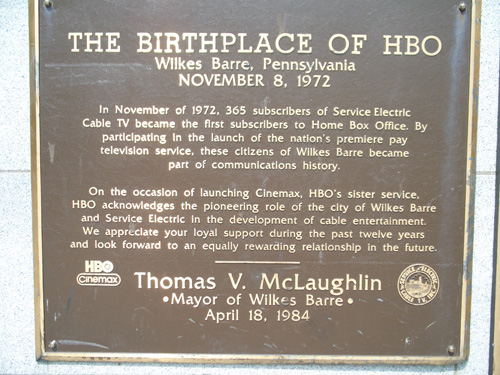
Plaque commemorating HBO’s first transmission.
On November 8th, 1972, HBO’s transmitted its first programs. They consisted of the movie “Sometimes a Great Notion” starring Paul Newman and Henry Fonda, a two year old motion picture from Universal. Then a live National Hockey League game between the New York Rangers and the Vancouver Canucks lfrom Madison Square Garden followed the film. From there, HBO would go on to pioneer the use of satellite delivery of its programming. On September 30th, 1975, HBO carried the heavy weight championship rematch of Joe Frazier and Muhammad Ali live from the Phillipines and delivered direct to the cable systems by satellite.
Gerald Levin talking about HBO’s first satellite transmission “The Thrilla from Manilla.”
Walson’s company, Service Electric Cable TV, is still in business today. It is unique among companies in that it has served the same communities continuously since the day it hooked up its first customer. Within 15 years after that first broadcast, HBO became an entertainment giant that is still going strong today.
From its roots of providing clear television pictures to mountainous areas, cable television has gone on to add programming sources to the television landscape that in turn have changed the face of home entertainment as well as sports and news broadcasting. But it faces the challenges of new technologies and as both Service Electric and HBO learned early on, they must quickly recognize and adapt to the fancies of the buying public.

Filmtools
Filmmakers go-to destination for pre-production, production & post production equipment!
Shop Now









